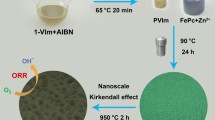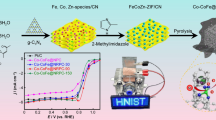Abstract
Highly dispersed electrocatalysts and single-atom catalysts receive extensive attention in the field of multiple reactions involving water spitting, oxygen reduction, and CO2 reduction. Herein, we develop a Fe/N co-doped hierarchically structured porous carbon (Fe/N/C-DT) by the dual-templating approach, involving the incorporation of ferrocenecarboxaldehyde (Fc–CHO) into the polyimide, followed by carbonization at 900 °C and etching. A steric hindrance offered by the ferrocene and the porosity of the obtained nanostructure prevent the aggregation of Fe atoms, resulting in the maximization of catalytic efficiency of iron-based sites. FeCl2/N/C-DT and FeSO4/N/C-DT using FeCl2 and FeSO4 as iron sources, respectively, are prepared for comparison, to further confirm the potential positive effect of Fc–CHO and explore the synergistic effect of the pentagon defects and Fe–N4 on the catalytic performance in oxygen reduction reaction (ORR). The prepared Fe/N/C-DT exhibits outstanding electrochemical activity toward ORR (E1/2 = 0.902 V vs RHE) and impressive OER activity (Ej=10 = 1.66 V) in alkaline conditions. The rechargeable Zn–air battery using Fe/N/C-DT as a cathode catalyst shows a peak power density of 220 mW cm−2 and a high open–circuit voltage of 1.451 V in the all-solid-state Zn–air battery.





Similar content being viewed by others
References
Seh ZW, Kibsgaard J, Dickens CF, Chorkendorff IB, Nørskov JK, Jaramillo TF (2017) Combining theory and experiment in electrocatalysis: insights into materials design. Science 355:eaad4998
Nørskov JK, Rossmeisl J, Logadottir A, Lindqvist LR, Kitchin JR, Bligaard T, Jonsson H (2004) Origin of the overpotential for oxygen reduction at a fuel-cell cathode. J Phys Chem B 108:17886–17892
Chen YN, Guo Y, Cui H, Xie Z, Zhang X, Wei J, Zhou Z (2018) Bifunctional electrocatalysts of MOF-derived Co–N/C on bamboo-like MnO nanowires for high-performance liquid-and solid-state Zn–air batteries. J Mater Chem A 6:9716–9722
Zhang R, He S, Lu Y, Chen W (2015) Fe Co, N-functionalized carbon nanotubes in situ grown on 3D porous N-doped carbon foams as a noble metal-free catalyst for oxygen reduction. J Mater Chem A 3:3559–3567
Yi JD, Xu R, Wu Q, Zhang T, Zang KT, Luo J, Liang YL, Huang YB, Cao R (2018) Atomically dispersed iron–nitrogen active sites within porphyrinic triazine-based frameworks for oxygen reduction reaction in both alkaline and acidic media. ACS Energy Lett 3:883–889
Jiang WJ, Gu L, Li L, Zhang Y, Zhang X, Zhang LJ, Wang JQ, Hu JS, Wei Z, Wan LJ (2016) Understanding the high activity of Fe–N–C electrocatalysts in oxygen reduction: Fe/Fe3C nanoparticles boost the activity of Fe–Nx. J Am Chem Soc 138(10):3570–3578
Hadidi L, Davari E, Ivey DG, Veinot JG (2017) Microwave-assisted synthesis and prototype oxygen reduction electrocatalyst application of N-doped carbon-coated Fe3O4 nanorods. Nanotechnology 28:095707
Zitolo A, Goellner V, Armel V, Sougrati MT, Mineva T, Stievano L, Fonda E, Jaouen F (2015) Identification of catalytic sites for oxygen reduction in iron-and nitrogen-doped graphene materials. Nat Mater 14:937
Li J, Ghoshal S, Liang W, Sougrati MT, Jaouen F, Halevi B, McKinney S, McCool G, Ma C, Yuan X, Ma ZF (2016) Structural and mechanistic basis for the high activity of Fe–N–C catalysts toward oxygen reduction. Energ Environ Sci 9:2418–2432
Su J, Ge R, Dong Y, Hao F, Chen L (2018) Recent progress in single-atom electrocatalysts: concept, synthesis, and applications in clean energy conversion. J Mater Chem A 6:14025–14042
Mun Y, Kim MJ, Park SA, Lee E, Ye Y, Lee S, Kim YT, Kim S, Kim OH, Cho YH, Sung YE (2018) Soft-template synthesis of mesoporous non-precious metal catalyst with Fe–Nx/C active sites for oxygen reduction reaction in fuel cells. Appl catal B-Environ 222:191–199
Zhang Z, Sun J, Wang F, Dai L (2018) Efficient oxygen reduction reaction (ORR) catalysts based on single iron atoms dispersed on a hierarchically structured porous carbon framework. Angew Chem Int Edit 57:9038–9043
Chung HT, Cullen DA, Higgins D, Sneed BT, Holby EF, More KL, Zelenay P (2017) Direct atomic-level insight into the active sites of a high-performance PGM-free ORR catalyst. Science 357:479–484
Hou J, Cao C, Idrees F, Ma X (2015) Hierarchical porous nitrogen-doped carbon nanosheets derived from silk for ultrahigh-capacity battery anodes and supercapacitors. ACS Nano 9:2556–2564
Zhang C, Kong R, Wang X, Xu Y, Wang F, Ren W, Wang Y, Su F, Jiang JX (2017) Porous carbons derived from hypercrosslinked porous polymers for gas adsorption and energy storage. Carbon 114:608–618
Rehman S, Guo S, Hou Y (2016) Rational design of Si/SiO2@ hierarchical porous carbon spheres as efficient polysulfide reservoirs for high-performance Li–S battery. Adv Mater 28:3167–3172
Peng Y, Lu B, Chen S (2018) Carbon-supported single atom catalysts for electrochemical energy conversion and storage. Adv Mater 30:1801995
Jackson C, Smith GT, Inwood DW, Leach AS, Whalley PS, Callisti M, Polcar T, Russell AE, Levecque P, Kramer D (2017) Electronic metal-support interaction enhanced oxygen reduction activity and stability of boron carbide supported platinum. Nat Commun 8:15802
Chen HK (2001) Kinetic study on the carbothermic reduction of zinc oxide. Scand J Metall 30:292–296
Proietti E, Jaouen F, Lefèvre M, Larouche N, Tian J, Herranz J, Dodelet JP (2011) Iron-based cathode catalyst with enhanced power density in polymer electrolyte membrane fuel cells. Nat Commun 2:416
Shui J, Chen C, Grabstanowicz L, Zhao D, Liu DJ (2015) Highly efficient nonprecious metal catalyst prepared with metal–organic framework in a continuous carbon nanofibrous network. P Natl Acad Sci 112:10629–10634
Wang C, Chen W, Xia K, Xie N, Wang H, Zhang Y (2019) Silk-derived 2D porous carbon nanosheets with atomically-dispersed Fe–Nx–C sites for highly efficient oxygen reaction catalysts. Small 15:1804966
Razmjooei F, Singh KP, Bae EJ, Yu JS (2015) A new class of electroactive Fe-and P-functionalized graphene for oxygen reduction. J Mater Chem A. 3:11031–11039
Du C, Liu X, Ye G, Gao X, Zhuang Z, Li P, Xiang D, Li X, Clayborne AZ, Zhou X, Chen W (2019) Balancing the micro- mesoporosity for activity maximization of N-doped carbonaceous electrocatalysts for the oxygen reduction reaction. Chemsuschem 12:1017–1025
Zhang J, Zhao Z, Xia Z, Dai L (2015) A metal-free bifunctional electrocatalyst for oxygen reduction and oxygen evolution reactions. Nat Nanotechnol 10:444
Zhang R, Zhang C, Chen W (2016) FeP embedded in N, P dual-doped porous carbon nanosheets: an efficient and durable bifunctional catalyst for oxygen reduction and evolution reactions. J Mater Chem A 4:18723–18729
Wang YC, Lai YJ, Song L, Zhou ZY, Liu JG, Wang Q, Yang XD, Chen C, Shi W, Zheng YP, Rauf M (2015) S-doping of an Fe/N/C ORR catalyst for polymer electrolyte membrane fuel cells with high power density. Angew Chem Int Edit 54:9907–9910
Zhu J, Huang Y, Mei W, Zhao C, Zhang C, Zhang J, Amiinu IS, Mu S (2019) Effects of intrinsic pentagon defects on electrochemical reactivity of carbon nanomaterials. Angew Chem 131:3899–38904
Astruc D (2017) Why is ferrocene so exceptional? Eur J Inorg Chem 2017(1):6–29
Gu J, Du Z, Zhang C, Yang S (2016) Pyridinic nitrogen-enriched carbon nanogears with thin teeth for superior lithium storage. Adv Energy Mater 6:1600917
Zhou B, Liu L, Cai P, Zeng G, Li X, Wen Z, Chen L (2017) Ferrocene-based porous organic polymer derived high-performance electrocatalysts for oxygen reduction. J Mater Chem A 5:22163–22169
Jin H, Zhou H, Li W, Wang Z, Yang J, Xiong Y, He D, Chen L, Mu S (2018) In situ derived Fe/N/S-codoped carbon nanotubes from ZIF-8 crystals as efficient electrocatalysts for the oxygen reduction reaction and zinc–air batteries. J Mater Chem A. 6:20093–20099
Liu Y, Huang B, Zhang X, Huang X, Xie Z (2019) In-situ fabrication of nitrogen-doped carbon nanosheets containing highly dispersed single iron atoms for oxygen reduction reaction. J Power Sources 412:125–133
Jaroniec M, Solovyov LA (2006) Improvement of the Kruk–Jaroniec–Sayari method for pore size analysis of ordered silicas with cylindrical mesopores. Langmuir 22:6757–6760
Guo D, Shibuya R, Akiba C, Saji S, Kondo T, Nakamura J (2016) Active sites of nitrogen-doped carbon materials for oxygen reduction reaction clarified using model catalysts. Science 351:361–365
Xiang D, Bo X, Gao X, Zhang C, Du C, Zheng F, Zhuang Z, Li P, Zhu L, Chen W (2019) Novel one-step synthesis of core@ shell iron–nickel alloy nanoparticles coated by carbon layers for efficient oxygen evolution reaction electrocatalysis. J Power Sources 438:226988
Lee CH, Lee J, Yeo S, Lee SH, Kim T, Cha HG, Eun Y, Park HJ, Kim SM, Lee KH (2017) Evolution of implanted Fe ions in SiO2/Si wafer into uniformly sized catalyst particles for carbon nanotube forest growth. Carbon 123:122–128
Li W, Liang C, Qiu J, Zhou W, Han H, Wei Z, Sun G, Xin Q (2002) Carbon nanotubes as support for cathode catalyst of a direct methanol fuel cell. Carbon 40:787–790
Cao R, Thapa R, Kim H, Xu X, Kim MG, Li Q, Park N, Liu M, Cho J (2013) Promotion of oxygen reduction by a bio-inspired tethered iron phthalocyanine carbon nanotube-based catalyst. Nat Commun 4:2076
Szakacs CE, Lefèvre M, Kramm UI, Dodelet JP, Vidal F (2014) A density functional theory study of catalytic sites for oxygen reduction in Fe/N/C catalysts used in H2/O2 fuel cells. Phys Chem Chem Phys 16:13654–13661
Wang XR, Liu JY, Liu ZW, Wang WC, Luo J, Han XP, Du XW, Qiao SZ, Yang J (2018) Identifying the key role of pyridinic-N–Co bonding in synergistic electrocatalysis for reversible ORR/OER. Adv Mater 30:1800005
Acknowledgements
The authors wish to acknowledge the National Natural Science Foundations of China (No. 21473128) for financial assistance.
Author information
Authors and Affiliations
Corresponding authors
Ethics declarations
Conflict of interest
The authors declare no conflict of interest.
Additional information
Publisher's Note
Springer Nature remains neutral with regard to jurisdictional claims in published maps and institutional affiliations.
Electronic supplementary material
Below is the link to the electronic supplementary material.
Rights and permissions
About this article
Cite this article
Zeng, Z., Yi, L., He, J. et al. Hierarchically porous carbon with pentagon defects as highly efficient catalyst for oxygen reduction and oxygen evolution reactions. J Mater Sci 55, 4780–4791 (2020). https://doi.org/10.1007/s10853-019-04327-5
Received:
Accepted:
Published:
Issue Date:
DOI: https://doi.org/10.1007/s10853-019-04327-5




